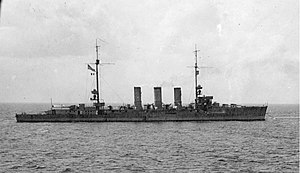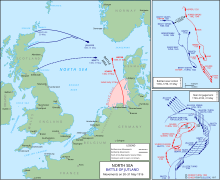SMS Wiesbaden
 Wiesbaden's sister ship Frankfurt
| |
| History | |
|---|---|
| Name | SMS Wiesbaden |
| Builder | A.G. Vulcan |
| Laid down | 1913 |
| Launched | 20 January 1915 |
| Commissioned | 23 August 1915 |
| Fate | Sunk at the Battle of Jutland, 1 June 1916 |
| General characteristics | |
| Class and type | Wiesbaden-class light cruiser |
| Displacement |
|
| Length | 145.30 m (476 ft 8 in) |
| Beam | 13.90 m (45 ft 7 in) |
| Draft | 5.76 m (18.9 ft) |
| Installed power |
|
| Propulsion |
|
| Speed | 27.5 knots (50.9 km/h; 31.6 mph) |
| Range | 4,800 nmi (8,900 km; 5,500 mi) at 12 knots (22 km/h; 14 mph) |
| Crew |
|
| Armament |
|
| Armor |
|
SMS Wiesbaden[a] was a light cruiser of the Wiesbaden class built for the Imperial German Navy (Kaiserliche Marine). She had one sister ship, SMS Frankfurt; the ships were very similar to the previous Karlsruhe-class cruisers. The ship was laid down in 1913, launched in January 1915, and completed by August 1915. Armed with eight 15 cm SK L/45 guns, Wiesbaden had a top speed of 27.5 knots (50.9 km/h; 31.6 mph) and displaced 6,601 t (6,497 long tons; 7,276 short tons) at full load.
Wiesbaden saw only one major action, the
Design
Wiesbaden was 145.30 meters (476 ft 8 in)
The ship was armed with a
Service history
Wiesbaden was ordered under the contract name "
Battle of Jutland

Commanded by Captain Fritz Reiss, Wiesbaden was assigned to II Scouting Group of light cruisers under Konteradmiral Friedrich Boedicker, which took part in the Battle of Jutland on 30 May and 1 June 1916.[4] Wiesbaden's sister ship Frankfurt served as Boedicker's flagship. The unit was assigned to screen for the battlecruisers of Vizeadmiral Franz von Hipper's I Scouting Group. At the start of the battle, Wiesbaden was cruising to starboard, which placed her on the disengaged side when Elbing, Pillau, and Frankfurt first engaged the British cruiser screen.[5]
At around 18:30,
Shortly after 20:00, III Flotilla of torpedo boats attempted to rescue Wiesbaden's crew, but heavy fire from the British battle line drove them off.[8] Another attempt to reach the ship was made, but the torpedo boat crews lost sight of the cruiser and were unable to locate her. The ship finally sank sometime between 01:45 and 02:45. Only one crew member survived the sinking; he was picked up by a Norwegian steamer the following day.[9] Among the 589 killed was the well-known writer of poetry and fiction dealing with the life of fishermen and sailors, Johann Kinau, known under his pseudonym of Gorch Fock, who has since then been honored by having two training windjammers of the Kriegsmarine and the German Navy, respectively, named after him.[10][11][12] The wreck of Wiesbaden was found in 1983 by divers of the German Navy, who removed both of the ship's screws. The ship lies on the sea floor upside down, and was the last German cruiser sunk at Jutland to be located.[13]
Notes
Footnotes
- Seiner Majestät Schiff" (German: His Majesty's Ship).
- ^ German warships were ordered under provisional names. For new additions to the fleet, they were given a single letter; for those ships intended to replace older or lost vessels, they were ordered as "Ersatz (name of the ship to be replaced)".
- ^ The times mentioned in this section are in CET, which is congruent with the German perspective. This is one hour ahead of UTC, the time zone commonly used in British works.
Citations
- ^ Gröner, p. 111.
- ^ a b Gröner, pp. 111–112.
- ^ Campbell & Sieche, p. 162.
- ^ Bennett, p. 222.
- ^ Tarrant, pp. 62, 70, 96.
- ^ Tarrant, pp. 127–128, 137–141.
- ^ Campbell, p. 164.
- ^ Tarrant, pp. 170–171.
- ^ Campbell, pp. 214, 294–295.
- ^ Gröner, p. 112.
- ^ Furness & Humble, p. 87.
- ^ Hadley, p. 65.
- ^ Thomas Nielsen (2010). "Battle of Jutland 2010". No Limits Diving. Retrieved 28 December 2011.
References
- ISBN 978-1-84415-300-8.
- Campbell, John (1998). Jutland: An Analysis of the Fighting. London: Conway Maritime Press. ISBN 978-1-55821-759-1.
- Campbell, N. J. M. & Sieche, Erwin (1986). "Germany". In Gardiner, Robert & Gray, Randal (eds.). Conway's All the World's Fighting Ships 1906–1921. London: Conway Maritime Press. pp. 134–189. ISBN 978-0-85177-245-5.
- Furness, Raymond & Humble, Malcolm (1997). A Companion to Twentieth-century German Literature. London: Routledge. ISBN 0-415-15057-4.
- ISBN 978-0-87021-790-6.
- Hadley, Michael L. (1995). Count Not The Dead: The Popular Image of the German Submarine. Annapolis: Naval Institute Press. ISBN 0-7735-1282-9.
- Tarrant, V. E. (1995). Jutland: The German Perspective. London: Cassell Military Paperbacks. ISBN 978-0-304-35848-9.
Further reading
- ISBN 978-1-68247-745-8.
